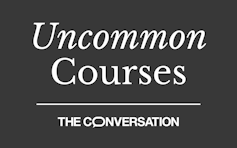Buddha’s lessons on impermanence are carved into monuments and buildings – this course explores why
- Written by Mitch Hendrickson, Associate Professor of Archeology, University of Illinois Chicago

Learning about the Buddha’s Middle Way[12], a way of life that recognizes and threads the extremes of asceticism and hedonism, provides a way of living life in balance.
What’s a critical lesson from the course?
In asking how Buddhism gained such a vast material presence in the archaeological record, we need to understand how a religion manages to survive over time. Religion is important to individuals as well as societies and often becomes an important tool of state power. Countless examples from the past[13] emphasize how kings and commoners provided for the Buddha and later monks and nuns by giving land, food and donations.
For the elites, donating funds for monasteries and monuments ramps up their own individual merit but can also serve as a way of asserting power[14] by becoming “Buddha-like” in the eyes of the masses. This fact makes us think generally about how patronage benefits patrons today and see how politics and economics are always present in a religion.
Finally, despite the somewhat contradictory fact that thousands of ancient Buddhist monuments exist across Asia, the class also learns an undeniable fact about culture: It is both impermanent and constantly changing.
What will the course prepare students to do?
Beyond gaining an understanding of where one could go to pursue research on Buddhism’s past, students learn a vital skill to make future trips to the museum more enjoyable: being able to distinguish the meaning of seemingly identical seated and standing Buddha statues from their hand gestures[15] alone.
The meaning of hand gestures.In our fast-paced and overstimulated world, the ability to appreciate and understand little details and nuances in life is something we can all benefit from.
References
- ^ Uncommon Courses (theconversation.com)
- ^ doctrinal story of the Buddha’s life (www.worldhistory.org)
- ^ the political, social and economic issues of the time (doi.org)
- ^ political feuding (www.ndtv.com)
- ^ claim ownership (www.thehindu.com)
- ^ over his place of birth (doi.org)
- ^ woodblock press was developed (education.asianart.org)
- ^ votive stelae (www.artic.edu)
- ^ expansion beyond India (en.unesco.org)
- ^ such as Nalanda in eastern India (www.bbc.com)
- ^ franck metois/Moment via Getty Images (www.gettyimages.com)
- ^ the Buddha’s Middle Way (www.buddhanet.net)
- ^ examples from the past (www.buddhanet.net)
- ^ as a way of asserting power (www.oxfordbibliographies.com)
- ^ hand gestures (buddhismforkids.net)
Authors: Mitch Hendrickson, Associate Professor of Archeology, University of Illinois Chicago

